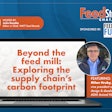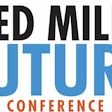Transcript of FG Chat with Maye Walraven, North American general manager and chief impact officer, Innovafeed
Elise Schafer, editor of Feed & Grain: Hi, everyone, and welcome to Feed & Grain Chat. I'm your host Elise Schafer, editor of Feed & Grain. This Chat edition is brought to you by the Feed mill of the Future Conference, a half day event bringing together leading feed industry experts to examine emerging feed mill technologies poised to impact animal feed manufacturing, taking place January 30, at IPPE 2024.
The conference is produced by Feed Strategy and Feed & Grain, organized in partnership with the American Feed Industry Association. To learn more about the 2024 Feed Mill of the Future Conference and to register, visit feedmillofthefuture.com.
Today I'm joined on Zoom by one of our Feed Mill of the Future Conference panelists, Maye Walraven, Innovafeed’s North American general manager and chief impact officer. Innovafeed is a global insect producer for animal and plant nutrition. Hi, Maye, how are you today?
Maye Walraven, North American general manager and chief impact officer, Innovafeed: Hi, Elise, great. Thanks for having me.
Schafer: Well, thank you for coming on. What properties of insects are ideal for cultivation as an alternative protein source for animal feed?
Walraven: Well, insects are in a way, nature's super upcycler. If you think about insects' role in nature, they tend to eat decaying biomass that's kind of poor in nutrients. And they concentrate this nutrient in a super food for other animals, small mammals, birds, even fish feed on insects in nature. And so in a way, it's surprising they haven't been used in our food chains to this day because we have huge biomass stocks around the world that are byproducts from our current agri-industry that can be used to feed insects and hence, upcycled into high quality ingredients — high quality protein, high quality source of oil and fatty acid.
And all part of the insect production can be recycled because we also recycle insect poop and we use it for plant nutrition as an organic fertilizer. So, insects really have this superpower of upcycling what can be considered waste into high quality nutrients, which makes them a really great alternative for the future to bring more circularity into our food chains.
Schafer: So, in what ways does Innovafeed embrace circularity in terms of resource utilization and reducing waste streams?
Walraven: Yeah, we had the chance to be working with a blank slate, so we could design our processes from zero and we figured out how can we maximize the circularity of our production model. And because we're using waste from another industry, we decided that we would co-locate our insect farms with existing agricultural plants that transform cereal and have an over-the-fence model where we use the byproducts to feed our insects.
When we do that we avoid a lot of transport by truck because we're piping the byproducts from one facility to another. But we also avoid a very energy intensive drying step that these products generally have to undergo, as they're generated — as we call wet with about 70 to 80% water — and our insects can actually eat them under the wet form, hence bypassing that drying step, the energy and the CO2 emissions that are related to it. But as we have explored this colocation model, which we refer to as industrial symbiosis, because we tried to find all the symbiotic ways to collaborate with these partners, we realized that these large agricultural facilities often had waste heat on top of waste byproducts, and so that waste heat can be used to heat our facilities. And about 60% of our energy needs are the use of this waste energy.
Schafer: How critical is expanding circular economies in agriculture to its ability to preserve the planet for future generations?
Walraven: Well, today we know we're going to have to feed about 10 billion people and that the land used for agriculture is already very stretched — 77% of agricultural land is actually used to feed livestock for meat and dairy production. And that land could go into feeding humans directly. So we must find alternative ways to feed livestock and insect is one of them. If you think of how we're going to provide protein to the world tomorrow, we actually know this huge protein deficit that is looming if we want to help feed this growing population in a healthy way, and meat, we know, has a huge impact on resources and on co2 emissions.
We see the growth of aquaculture as a very sustainable source of protein, but one that relies heavily on marine resources for that industry to grow. And we see insects as a solution here to lower the impact both on land utilization, but also on the pressure of marine resources, where we wouldn't need any additional raw material than what is already produced today in order to build this whole new industry.
And so I think it is critical if we want to be able to produce more with the same amount of resources and less impact on the environment and on climate change to introduce this level of circularity into our food chains.
Schafer: Well said, Maye. Thank you so much for your insights today.
Walraven: Thank you for your interest in our growing industry.
Schafer: Well, that's all for today’s Feed & Grain Chat. And if you'd like to learn more about today's topic, attend "How Circular Economies Reduce Waste in Feed Production, Enhance Animal Nutrition" at Feed Mill of the Future Conference. For more information, visit feedmillofthefuture.com. Thanks for watching, and we hope to see you next time.
THE FEED MILL OF THE FUTURE CONFERENCE IS SPONSORED BY



















